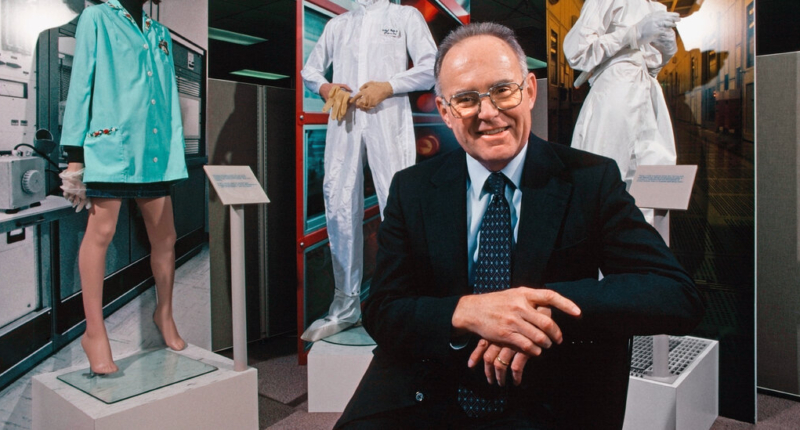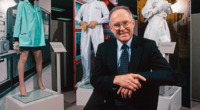Gordon Moore, the co-founder of Intel, has passed away at the age of 92. Moore, who was also known for “Moore’s Law,” was instrumental in the development of the semiconductor industry, which led to the creation of the modern computer. He co-founded Intel with Robert Noyce and Andy Grove in 1968 and served as the company’s CEO until 1975. Moore’s Law, which he formulated in the mid-1960s, predicted that the number of transistors on a microchip would double every 18 to 24 months, thereby driving down the cost of computing. By the 1990s, Intel’s microprocessors were in 80% of computers made worldwide. Moore’s legacy is his prescient insight that semiconductor devices were the way electronics would become cheap.
Gordon E. Moore: The Man Behind Moore’s Law
Gordon E. Moore, a co-founder and former chairman of Intel Corporation, passed away at the age of 94 at his home in Hawaii. He was instrumental in bringing about rapid advances in computer chip technology and charted a course for the age of high tech.
Mr. Moore was one of the few individuals who helped give Silicon Valley its name and achieved industrial dominance that was once held by the giant American railroad or steel companies of another age. He was an accidental entrepreneur who became a billionaire as a result of an initial $500 investment in the fledgling microchip business, which turned electronics into one of the world’s largest industries.
In 1965, Mr. Moore predicted that the number of transistors that could be placed on a silicon chip would double at regular intervals for the foreseeable future, thus increasing the data-processing power of computers exponentially. This prediction came to be known as Moore’s Law, which held up for decades.
Through Mr. Moore’s brilliance, leadership, charisma, and contacts, as well as that of his partner and Intel co-founder, Robert Noyce, the two assembled a group that was widely regarded as among the boldest and most creative technicians of the high-tech age. This group advocated the use of the thumbnail-thin chips of silicon, a highly polished, chemically treated sandy substance because of what turned out to be silicon’s amazing hospitality in housing smaller and smaller electronic circuitry that could work at higher and higher speeds.
Thanks to Mr. Moore’s prediction, laptop computers became accessible to hundreds of millions of people, and microprocessors were embedded into everything from bathroom scales, toasters, and toy fire engines to cellphones, cars, and jets. He added two corollaries later: The evolving technology would make computers more and more expensive to build, yet consumers would be charged less and less for them because so many would be sold.
Mr. Moore had wanted to be a teacher but could not get a job in education. However, he saw the future of technology and helped shape it, becoming a legend in his field. His legacy and impact on the world of technology and the modern world as a whole will undoubtedly continue for decades to come.
Gordon E. Moore: The Intel Co-Founder Behind Moore’s Law
Gordon E. Moore, one of the co-founders and former chairman of Intel Corporation, played a significant role in the development of the computer processing technology that is used today. He was instrumental in bringing about rapid advances in computer chip technology and charted a course for the age of high tech.
Under Mr. Moore’s leadership as chief executive from 1975 to 1987, and as chairman until 1997, Intel became the most successful semiconductor company in history. With its silicon microprocessors, Intel enabled American manufacturers in the mid-1980s to regain the lead in the vast computer data-processing field from their formidable Japanese competitors. By the 1990s, Intel had placed its microprocessors in 80 percent of the computers that were being made worldwide.
Mr. Moore’s most significant contribution to the world of technology was his prediction in 1965 that the number of transistors that could be placed on a silicon chip would double at regular intervals, thus increasing the data-processing power of computers exponentially. This prediction, known as Moore’s Law, held up for decades and became a cornerstone of the technology industry, as companies based their product strategy on the assumption that Moore’s Law would hold.
In addition to his technical contributions, Mr. Moore also became a major figure in philanthropy. In 2001, he and his wife created the Gordon and Betty Moore Foundation with a donation of 175 million Intel shares. The foundation’s assets currently exceed $8 billion, and it has given away more than $5 billion since its founding. In 2001, they donated $600 million to the California Institute of Technology, the largest single gift to an institution of higher learning at the time.
Mr. Moore was characteristically humble about his achievements, particularly the technical advances that Moore’s Law made possible. He believed that semiconductor devices were the way electronics were going to become cheap, and that was the message he was trying to get across. His prediction proved so reliable that technology firms based their product strategy on the assumption that Moore’s Law would hold.
Mr. Moore was born on January 3, 1929, in San Francisco, and grew up in Pescadero, a small coastal town south of San Francisco. He attended San Jose State College, where he met Betty Whitaker, a journalism student, and they married in 1950. That same year, he completed his undergraduate studies at the University of California, Berkeley, with a degree in chemistry. In 1954, he received his doctorate, also in chemistry, from Caltech.
Mr. Moore passed away on Friday, January 21, 2022, at his home in Hawaii at the age of 94. His legacy and impact on the world of technology and the modern world as a whole will undoubtedly continue for decades to come.
Gordon E. Moore: The Accidental Entrepreneur
Gordon E. Moore, one of the co-founders and former chairman of Intel Corporation, was not always set on being an entrepreneur. In fact, one of the first jobs he applied for was as a manager with Dow Chemical, but was told he would never manage anything. Instead, he joined the Applied Physics Laboratory at Johns Hopkins University in Baltimore. Later, he joined William Shockley, a co-inventor of the transistor, to work at a West Coast division of Bell Laboratories, which was aimed at making cheap silicon transistors.
However, the company, Shockley Semiconductor, foundered under Dr. Shockley, who had no experience running a company. In 1957, Mr. Moore and Mr. Noyce joined a group of defectors who came to be known as the “traitorous eight.” They left to form the Fairchild Semiconductor Corporation, which became a pioneer in manufacturing integrated circuits.
In 1968, bitten by the entrepreneurial bug, Mr. Moore and Mr. Noyce decided to form their own company, focusing on semiconductor memory. They wrote a “very general” business plan, which said they were going to work with silicon and make interesting products. With $2.5 million in capital, they called their start-up Integrated Electronics Corporation, later shortened to Intel.
Intel’s 4000 series “computer on a chip” began the revolution in personal computers, although Intel itself missed the opportunity to manufacture a PC, which Mr. Moore partly blamed on his own shortsightedness. “Long before Apple, one of our engineers came to me with the suggestion that Intel ought to build a computer for the home,” he recalled. “And I asked him, ‘What the heck would anyone want a computer for in his home?’”
Under Mr. Moore’s leadership, Intel became the most successful semiconductor company in history. With its silicon microprocessors, Intel enabled American manufacturers in the mid-1980s to regain the lead in the vast computer data-processing field from their formidable Japanese competitors. By the 1990s, Intel had placed its microprocessors in 80 percent of the computers that were being made worldwide.
Mr. Moore’s most significant contribution to the world of technology was his prediction in 1965 that the number of transistors that could be placed on a silicon chip would double at regular intervals, thus increasing the data-processing power of computers exponentially. This prediction, known as Moore’s Law, held up for decades and became a cornerstone of the technology industry, as companies based their product strategy on the assumption that Moore’s Law would hold.
In addition to his technical contributions, Mr. Moore also became a major figure in philanthropy. In 2001, he and his wife created the Gordon and Betty Moore Foundation with a donation of 175 million Intel shares. The foundation’s assets currently exceed $8 billion, and it has given away more than $5 billion since its founding. In 2001, they donated $600 million to the California Institute of Technology, the largest single gift to an institution of higher learning at the time.
Mr. Moore passed away on January 21, 2022, at his home in Hawaii at the age of 94. His legacy and impact on the world of technology and the modern world as a whole will undoubtedly continue for decades to come.
Gordon Moore, co-founder of Intel, passed away at the age of 92 in January 2022. Moore played a critical role in creating the foundation for Silicon Valley and transforming the tech industry. He predicted the exponential growth of computer power, known as “Moore’s Law,” which has guided the semiconductor industry for over 50 years. Moore’s Law anticipated that the number of transistors on a chip would double at regular intervals, making electronics less expensive and more widely available.
Moore’s Law made him a highly respected figure in the tech world, and he was considered an intellectual and entrepreneurial powerhouse. His technical insights and leadership skills helped Intel become one of the most significant companies in the history of Silicon Valley. In the mid-1980s, Intel’s silicon microprocessors enabled American manufacturers to outpace their Japanese competitors in the vast computer data-processing field. By the 1990s, Intel had placed its microprocessors in 80% of the computers being manufactured worldwide, and it became the most successful semiconductor company in history.
Moore was born in San Francisco in 1929 and earned a degree in chemistry from the University of California, Berkeley, and a doctorate from Caltech. He joined William Shockley, the co-inventor of the transistor, to work at a West Coast division of Bell Laboratories. In 1957, Moore and Robert Noyce joined a group of defectors who came to be known as “the traitorous eight.” They formed the Fairchild Semiconductor Corporation, which became a pioneer in manufacturing integrated circuits. In 1968, Moore and Noyce founded Intel, focusing on semiconductor memory.
Moore remained humble despite his achievements and said that he never expected Moore’s Law to be as precise as it turned out to be. In addition to his work at Intel, Moore became a significant figure in philanthropy, creating the Gordon and Betty Moore Foundation with a donation of 175 million Intel shares in 2001. The foundation has given away over $5 billion since its founding, and its assets currently exceed $8 billion.
Moore’s Law is bound to reach its end, as engineers encounter some physical limits and the extreme cost of building factories to achieve the next level of miniaturization. In recent years, the pace of miniaturization has slowed, leading to the end of Moore’s Law. However, Moore’s contributions to the tech industry remain invaluable.
Don’t miss interesting posts on Famousbio










